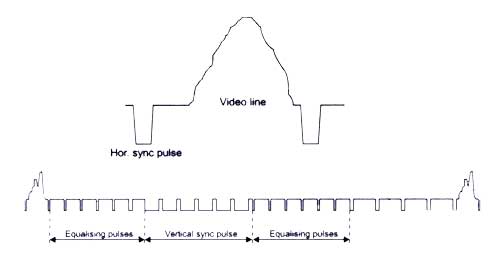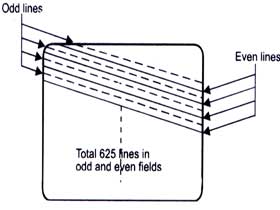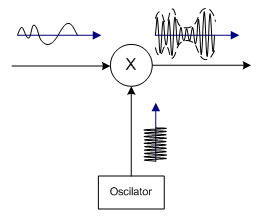-
GNU Radio FTW
09/17/2018 at 14:11 • 2 commentsOkay, I was wrong. It is entirely possible to implement PAL in GNU Radio and ffmpeg alone. The resulting GNU Radio flow graph looks something like this:
![]()
In general: Top part handles the brightness (Y) and the bottom part handles the color (UV). The part to the right combines both again.
The result looks something like this:
Color is still to be fixed.
The command line generating this:
$ ffmpeg -i /home/marble/lib/Videos/bigbuckbunny.mp4 -codec:v rawvideo -vf 'scale=702:576:force_original_aspect_ratio=decrease,pad=702:576:(ow-iw)/2:(oh-ih)/2' -f rawvideo -pix_fmt yuv444p -r 50 - | ~/curr/Software\ Proejcts/video2pal/grc/pal_transmit.py -
Working on Video
09/15/2018 at 23:22 • 0 commentsBeing able to transmit a still image is already quite fun, but of course I also want to be able to do moving picture.
The algorithm that implements the generation of a still images was purely implemented in python. Although python is a nice langue, it's not very fast without any external help.
I was thinking abut using numpy for matrix manipulation, but then I found out that ffmpeg can encode into raw YUV (aka Y Cb Cr) values.
ffmpeg -i /home/marble/lib/Videos/bigbuckbunny.mp4 \ -c:v rawvideo \ -vf 'scale=702:576:force_original_aspect_ratio=decrease,pad=702:576:(ow-iw)/2:(oh-ih)/2' \ -f rawvideo \ -pix_fmt yuv444p \ -r 50 \ -
This command not only transforms any video into a raw YUV stream and writes it to stdout, it also sets the frame rate to 50 fps, scales the video down to PAL resolution and applies letterboxing. For each video frame ffmpeg output a whole Y frame, then a U frame and then a V frame.
I tried to the the rest purely in gnuradio-companion, but as it turnes out, this would be really hard and quite a mess. So I turned back to python for the adding of synchronization pulses etc.
To use ffmpeg in python I use the subprocess module.
#!/usr/bin/env python3 import subprocess VISIB_LINES = 576 PIXEL_PER_LINE = 702 VIDEO_SCALE = '{}:{}'.format(PIXEL_PER_LINE, VISIB_LINES) ffmpeg = subprocess.Popen(['/usr/bin/ffmpeg', '-i', '/home/marble/lib/Videos/bigbuckbunny.mp4', '-c:v', 'rawvideo', '-vf', 'scale=' + VIDEO_SCALE + ':force_original_aspect_ratio=decrease,pad=' + VIDEO_SCALE + ':(ow-iw)/2:(oh-ih)/2', '-c:v', 'rawvideo', '-f', 'rawvideo', '-pix_fmt', 'yuv444p', '-r', '50', '-loglevel', 'quiet', # '-y', '-'], stdout = subprocess.PIPE) -
The Theory behind PAL (pt 2)
09/25/2016 at 17:16 • 1 commentEncoding color
YUV color space
In opposite to the RGB color space that we as hackers are used to, the image in PAL is encoded in YUV color space. The Y componen (the luma) is described in part 1 of The theory behind PAL. The U and V component are just other names for the intensity of red and blue (also called chroma blue [Cr] and chroma red [Cb]). As a reference to linear algebra, this is merely a base change.
[ Y ] [ 0.299 0.587 0.114 ] [ R ] [ U ] = [-0.147 -0.289 0.436 ]*[ G ] [ V ] [ 0.615 -0.515 -0.100 ] [ B ]
The green information is not lost, but endcode in Y, U, and V all together.Simplified: Y = Cr+Cg+Cb <=> Cg = Y-Cr-Cb
Modulation of U and V
To modulate the chroma alongside the luma in the signal, a process called Quadrature Amplitude Modulation (QAM) is used. The Wikipedia has a really good explanation of the process. The modulated signal is then a subcarrier of the main video signal.
Basically, what you can do, is have two scalar signals (our chroma values) and multiply each with two sinusoids having a 90° (π/2 [τ/4]) phase shift against each other. When you add these two resulting signal, you get a sinusoid which phase and amplitude depend on the value of the red and blue signal.
To make this a little bit easier to grasp, I've put together a little something in GeoGebra. The black line is the reference sinusoid which the phase shift will be measured to. The red and blue dotted line are the two sinusoids which are the two signals will be multiplied to. The purple line is the sum of u*blue and v *red.
![]()
![]()
As you can see, the change of the U and V signal result in a change of the the resulting signal towards the corresponding sinusoid. What we can do now of course is having a mixture of both.![]()
The math behind this is "simple" trigonometry. In the result the amplitude of the chroma signal isAnd the phase is
Resulting in
The formulas are especially interesting for demodulation, because now you derive the ration between red and blue from the phase angle
and the the brightness of both of these from the amplitude of the signal.
-
The Theory behind PAL (pt 1)
09/19/2016 at 08:11 • 0 commentsIn order to understand the structure of a PAL/NTSC signal, it's a good idea to understand the structure of a grayscale image signal first. The reason is that PAL and NTSC needed to be downward compatible and therefore interpretable by older b/w TV sets.
To keep writing simpler I will continue to only use "PAL" instead of "PAL/NTSC" and will add the distinction when needed.
![Visible Scan Lines in a monochrome signal]() Grayscale TV signals only transmit the brightness - the luma - of the image. This is simply encoded in the strengt of the signal. The higher the voltage, the brighter the point in the image. The way the image is build up is by multiple scan lines. You draw many lines one after the other and you get an image.
Grayscale TV signals only transmit the brightness - the luma - of the image. This is simply encoded in the strengt of the signal. The higher the voltage, the brighter the point in the image. The way the image is build up is by multiple scan lines. You draw many lines one after the other and you get an image.
![Voltage over Time of the Signal]() Each line is a waveform which represent the luma along the line. To keep the image aligned with the screen, h-sync ans v-sync pulses are used.
Each line is a waveform which represent the luma along the line. To keep the image aligned with the screen, h-sync ans v-sync pulses are used.
To maintain a high resolution and a high frame rate of 50 fps, the simple trick of interlacing lines is use. This means, that in the first 20ms only the odd lines are drawn and in the next 20ms the even ones. The only drawback of this is that motion blurr is now more visible and a scene change not as smooth.
![]()
Transmission of the signal is done by amplitude modulating it onto a carrier wave.
"In amplitude modulation, the amplitude (signal strength) of the carrier wave is varied in proportion to the waveform being transmitted." - Wikipedia
In digital signal processing this can be done by multiplying both signal.
Analog TV Broadcast of the new Age
How to broadcast colored PAL television with a SDR transmitter.
 marble
marble






